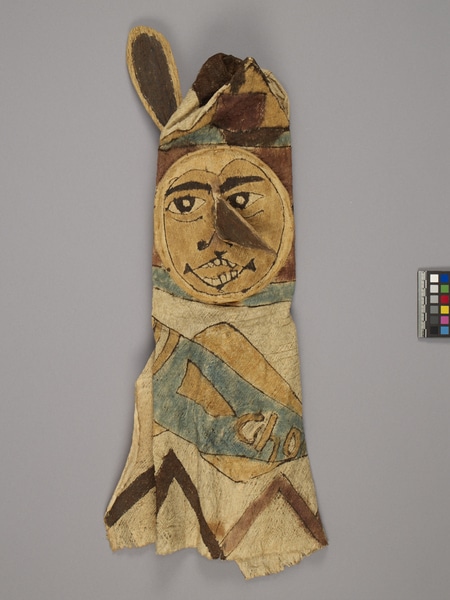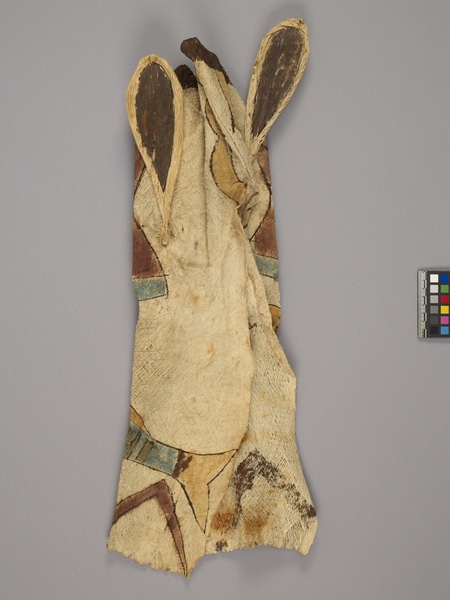Mask Item Number: 3062/1 from the MOA: University of British Columbia


Description
Painted bark cloth mask. Body of mask is made of a single piece of bark cloth, sewn together at the back of the head with the neck and shoulder portion remaining loose. A round panel stitched to the front is painted with large eyes, thick eyebrows and an open mouth with teeth. A large protruding nose of cloth emerges from the centre of the face. The forehead comes to a peak above the face panel. Two large oblong ears are attached to the piece on either side of the face and angle upwards. The body and head are painted with lines and colour blocks in blue, yellow and brown. The back of the cloth has paint marks from the painting on the front.
History Of Use
Ticuna art is traditionally related to ritual celebrations. Making and using masks are male activities. Men are also responsible for producing most of the objects used in Ticuna rituals, including musical instruments, ritual shelters and sculpted dance sticks.
Specific Techniques
The Ticuna utilize a very wide range of pigments and dyes; approximately fifteen species of plants are used to colour the threads for weaving bags and hammocks or painting bark, sculptures, baskets, sieves, musical instruments, paddles, gourds and the body itself. A number of mineral-based pigments are also used to decorate ceramics and the “heads” of ceremonial masks like this one.
Narrative
The Ticuna (Tikuna, Tukuna or Magüta) live around the border between Peru, Brazil and Colombia, where this mask was acquired. At nearly 54,000 individuals, they are the most numerous people in Brazilian Amazonia. They only gained official recognition for most of their lands in the 1990s. Today the Ticuna face the challenges of guaranteeing their economic and environmental sustainability and enhancing their relations with the surrounding society while maintaining the vivacity of their extremely rich culture. Not by chance, their masks, designs and paintings have achieved international recognition. During the last two decades of the 19th century, Amazonia became the setting for an intense period of rubber exploration. The upper reaches of the Solimões River were subject to this rush for “white gold,” as rubber was called.
Item History
- Made in Leticia, Amazonas, Colombia between 1950 and 1979
- Owned by James Cooke before May 1, 2014
- Received from James Cooke (Donor) on May 1, 2014
What
- Name
- Mask
- Identification Number
- 3062/1
- Type of Item
- mask
- Material
- bark, gourd fruit and paint
- Overall
- height 10.7 cm, width 65.5 cm, depth 31.0 cm
Who
- Culture
- Ticuna
- Previous Owner
- James Cooke
- Received from
- James Cooke (Donor)
Where
- Holding Institution
- MOA: University of British Columbia
- Made in
- Leticia, Amazonas, Colombia
When
- Creation Date
- between 1950 and 1979
- Ownership Date
- before May 1, 2014
- Acquisition Date
- on May 1, 2014
Other
- Item Classes
- textiles
- Condition
- good
- Accession Number
- 3062/0001